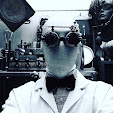I've watched the development of the drum-machine over the last 30 odd years go from the strict-time dance machines, usually found in home organs, to the uber-machines of today.
I've owned many of the lower-end machines and they still remain my favourites of the breed.
I began to take drum-machines seriously around 1978 when I found it nearly impossible to find a drummer who could play more than one type of rhythm, could play at a consistent tempo for more than 2 minutes and who owned a kit that didn't take up a whole room.
The first drum machine I laid hands on was an Electro-Harmonix Rhythm 12 I bought from a junk shop in Leeds:
It was a basic preset unit that offered a limited range of beats the most hilarious of which was preset 12 "Reggae".
It wasn't the answer I was looking for.
Things were beginning to move in the world of the drum-machine around that time and during 1978 the Roland Corporation released their
CR78 CompuRhythm which changed the game in that it allowed the user to programme 4 of it's memories (so long as the user bought the programming button add-on).
The downside of the CR78, for mere mortals, was the price.
In 1980 Roland's subsidiary company Boss released the
DR55 Dr. Rhythm.
Even though it's now considered a 'classic' I never really liked the sound of it. Far to harsh for my taste.
It had another downside.
It allowed the user to programme the bass drum, snare drum, rim-shot (ha!) and accent but not the hi-hat which could only be switched between 8's and 16's and didn't have an open hi-hat option.
I did end up owning one for a while but it wasn't my first programmable machine.
My first machine was
The SoundMaster Memory Rhythm SR88.
The picture is of a later variant of the SR88 which provided clock and step trigger outputs allowing the machine to control other devices.
More on that later.
The version I had came in a pale blue case and didn't have the trigger outputs.
Four fully programmable soft analogue sounds (BD,SD,HH,CY), allowed a fill variation to be added at 4, 8 or 16 bars and is still to this day my favourite drum-machine ever.
My approach to these machines was not to consider them 'drummers' but percussive instruments in their own right.
I developed a system of programming involving some element of chance based on this thinking:
Each bar memory had 16 steps (4 x 4).
Each step could be on or off.
I drew the variations (X=beat 0=rest) sets 01-08 start with a beat, sets 09-16 start with a rest:
01: X000 09: 0XXX
02: XX00 10: 00XX
03: XXX0 11: 000X
04: XXXX 12: 0000
05: X0X0 13: 0X0X
06: X0XX 14: 0X00
07: XX0X 15: 00X0
08: X00X 16: 0XX0
Usually I'd button-hole someone and ask them to give me 2 numbers between 01 & 08 and two numbers between 09 & 16 and those variations would become the bass drum patten.
Another set of four numbers would become the Hi-Hat patten.
The snare drum would be put in at beats 05 and 09 then, using a variation from the 01 to 08 column and stretching it over the 16 steps, I'd add the Open Hi-Hat.
So, a beat using pattens 01, 13, 5 & 14 for the bass drum, 05, 09, 06 and 16 for the Hi-hat, 06 for the open Hi-hat and a Snare drum on the off beat would sound like this:
SR88 Demo Beat which is nothing out of the ordinary but demonstrates the principle.
Another method was to just use one variation per drum per patten and run the drum-machine through an echo pedal which produced some fabulous beats.
The lack of any way of directly synchronising the drum-machine to my Wasp synth & Spider sequencer became frustrating so I traded my first SR88 for a Boss Dr. Rhythm but I was never happy with it and as soon as the upgraded SR88 appeared I dumped the Dr. Rhythm.
I look back on that period of about 2 years as being the most fun I've ever had during my whole involvement in electronic music.
I've owned lots of different drum-machines since then, some of which I can remember:
- Roland TR808
- Roland TR707
- Roland TR606 (c/w TB303 acid-machine)
- Yamaha RX21
- Boss DR110
- Boss DR220
- SoundMaster ST305
- Mattel Synsonic
- Korg MiniPops Jnr.
- Boss DR202 Dr. Groove.
but, given the choice and the huge amount of cash I'd need to buy one nowadays, I'd chose the SR88 every time.
I've downloaded the individual drum samples of the SR88 and used them in the Reason programme which allows me to press a button to randomise the patten but it's just not the same somehow.
Which brings me to the point of all this memory lane business.
Since I bought an iPod Touch I've wondered why no one's come up with an app that features all those Bump, Tish, Pop, Ticky, Ticky analogue drum-machines I love.
Then, last Thursday, I found someone had.
It's called
FunkBox (rubbish name) and even though it doesn't feature my beloved SoundMaster SR88 it has a version of the classic
Maestro Rhythm King Mk II which is all I'll ever need and can be heard here:
Update.
Having had an exchange of emails with the very helpful Mr. Chris Kerns at Synthetic Bits (FunkBox developers) I have the SR88 samples installed which now makes FunkBox the perfect drum-machine.
(I did add an apology for suggesting 'FunkBox' was a rubbish name.)























